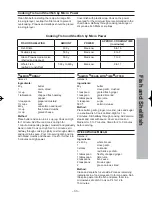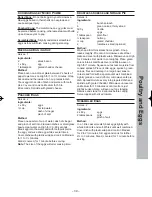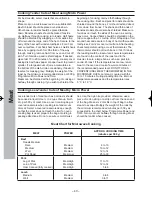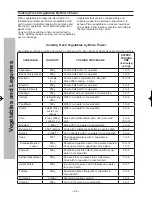
– 29 –
Reheat
Reheating
One of the most common uses for a microwave oven
is to reheat food. Your Panasonic microwave allows
you to either reheat by placing food into the oven
and you choose the micro power level and length
of heating time or you may reheat automatically by
using the AUTO REHEAT Pads on your microwave.
Following are some directions for reheating
pre-cooked foods from either frozen refrigerator
temperature or room temperature.
General rules for reheating foods by
Micro Power
• Many convenience foods contain heating
instructions on the packaging. It is best to follow
these instructions, being sure to check the wattage
of the oven they used and adjust the cooking time
if necessary (decrease cooking time by 10% for
every 100watts more powerful your oven is).
• If package directions are not available, follow the
recommendations in the charts on the following
pages.
• All foods must be pre-cooked; raw foods will
not cook through during reheating times and if
consumed may cause illness.
• Do not reheat in foil containers, cans or plastic
containers as incorrect heating times will result.
Place foods into microwave safe bowls or onto
dinner-plates before heating.
• Most foods can be heated on High but consider if
the food is delicate in structure like baked custard
or you have a large quantity, a lower power level for
slightly longer may be gentler.
• Cover foods with plastic wrap if you require a
steamed effect or leave uncovered for a drier
surface, e.g. Crumbed foods.
Note:
when cooking by Sensor Cook all food must
be covered.
• Stir or re-arrange foods during heating as this
will help food heat evenly. Stir after heating and
let stand for 2 to 3 minutes. Check temperatures
before adding extra heating time and ensure food is
hot. If food is not heated enough, consumption may
cause illness.
Caution:
Pastry items which have a
fi
lling that is high in
fat., sugar or moisture will become hotter in the
centre and the pastry may only feel warm. Ensure
you allow it to stand for several minutes before
eating.
IMPORTANT POINTS TO CONSIDER
WHEN REHEATING COLD FOODS
STARTING TEMPERATURE —
Foods taken from
the refrigerator will take longer to reheat than foods
from room temperature.
Quantity —
One serving heats faster than several
servings. When heating large quantities, stir food to
ensure even heating. It is quicker to heat individual
plates of food than large quantities in a casserole
dish.
Plated Dinners —
Arrange foods with the most
dense items towards the outside of the plate. Cover
meats with sauces/gravies if desired, spread out
mashed potatoes or rice so it heats more evenly.
When assembling plates of leftover foods, use foods
which have a similar starting temperature.
Covering Foods —
Most foods need to be covered
with one sheet of absorbent paper towel to hold in
the heat and prevent splattering without steaming.
When more moisture is desired, cover with plastic
wrap.
Heating —
Reheating is usually done on High,
however, if food has a more delicate texture, like
a baked custard, a lower power setting should be
used. Med-High for a little longer will be gentler on
the food. An average plate of food would generally
take 1 to 3 minutes to heat depending on the density
of the food. Place it in for the minimum time and add
extra heating time if required.
Ensure food is hot by feeling the bottom of the plate
in the centre. If the plate is cool, food may be warm
but will lose heat quickly as the plate will absorb the
heat and taste cold when served.
If food is not heated enough, consumption may
cause illness.
Elevation —
Elevate pastries and breads on a
small plastic rack with paper towel under the food to
prevent it from becoming soggy.
IMPORTANT POINTS TO CONSIDER
WHEN REHEATING FOODS FROM THE
FREEZER
VOLUME —
The greater the volume and the more
dense the item, the longer it takes to reheat. E.g.
frozen cake will take less time than frozen casserole.
LARGE VOLUME —
Large, dense, frozen
precooked foods are best thawed on defrost until icy
in the centre then heated on Med-High. This prevents
overcooking of the edges. Stirring is often needed to
distribute heat evenly.
F0003BN60QP.indb 29
F0003BN60QP.indb 29
2014/8/15 15:23:18
2014/8/15 15:23:18
















































